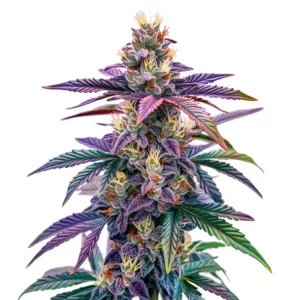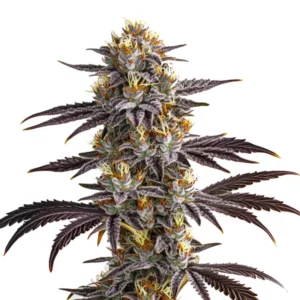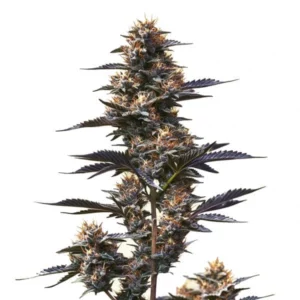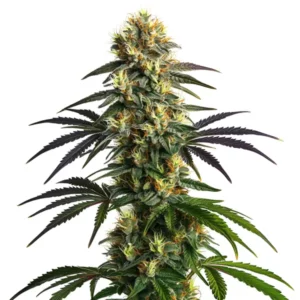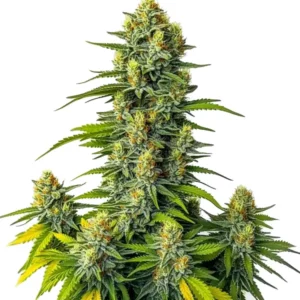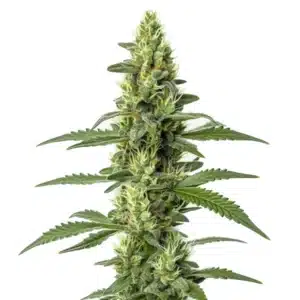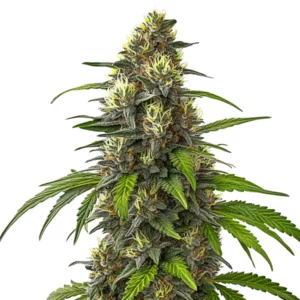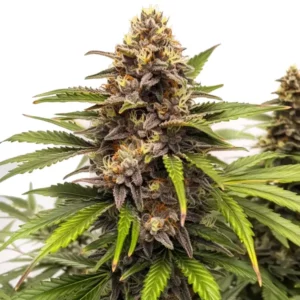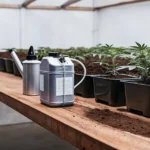
How to Fix Nutrient Flow Issues in Cannabis Due to Poor Transpiration: Guide
Poor transpiration can significantly affect the health of your cannabis plants. This process involves the movement of water through the plant and its evaporation from leaves, stems, and flowers. When transpiration is not functioning well, it can lead to nutrient flow issues. This is because nutrients dissolved in water are transported through the plant via transpiration. If you notice yellowing leaves or stunted growth, it might be time to learn how to fix nutrient flow issues in cannabis due to poor transpiration, as addressing this problem promptly can restore proper nutrient distribution and overall plant vitality.
Cannabis plants depend on a steady flow of nutrients to grow healthy and strong. When transpiration is hindered, nutrient uptake becomes inefficient. This can result in deficiencies that are visible in the plant’s appearance. To fix nutrient flow issues in cannabis due to poor transpiration, it’s crucial to understand what affects this process and how to optimize it. Proper water management, environmental control, and strain selection play key roles.
Recommended Strains
Blue Dream Autoflower
|
|
THC | 10% - 13% (Low) |
|
|
Type | Autoflowering |
|
|
Yield | Medium |
|
|
Phenotype | 30% Indica / 70% Sativa |
Gelato Auto
|
|
THC | 19% - 21% (Medium) |
|
|
Type | Autoflowering |
|
|
Yield | Medium |
|
|
Phenotype | 40% Indica / 60% Sativa |
Choosing the right cannabis strains can also help improve transpiration efficiency. Some strains are naturally better at managing water and nutrient uptake, such as the Blue Dream Auto from Blimburn Seeds. This strain is known for its resilience and ability to thrive in various conditions, making it a great choice for growers facing transpiration issues.
Environmental Factors Affecting Transpiration
The environment in which cannabis plants are grown plays a significant role in transpiration. Temperature, humidity, and airflow all impact how well a plant can transpire. High humidity levels can slow down transpiration because the air is already saturated with moisture. This means the plant doesn’t release as much water vapor, affecting nutrient flow.
To improve cannabis transpiration for nutrient flow, consider adjusting the grow room conditions. Increasing airflow with fans can help water evaporate more efficiently from the leaves. Additionally, maintaining an optimal temperature range encourages better transpiration. Strains like Gelato Auto are known for performing well under diverse environmental conditions, making them suitable for growers looking to optimize their setup.
Light exposure is another critical environmental factor that can affect transpiration. Adequate light levels stimulate photosynthesis and encourage the plant to transpire at a healthy rate. Ensuring your cannabis plants receive adequate light can help in fixing nutrient transport issues in cannabis plants by promoting more effective water and nutrient movement.
Another aspect to consider is the type of substrate or growing medium used, as it can impact the plant’s ability to transpire efficiently. Some growing media hold moisture better than others, affecting how water moves through the plant. Using a well-aerated medium can enhance nutrient flow in cannabis by boosting transpiration.
Humidity Control
Controlling humidity is crucial in fixing nutrient transport issues in cannabis plants. If the air is too humid, the plant struggles to release water through its leaves. This stagnation can cause nutrients to get stuck, leading to deficiencies. By using a dehumidifier, you can lower humidity levels, encouraging the plant to transpire more efficiently.
On the flip side, if the air is too dry, the plant may transpire too quickly, causing it to lose water faster than it can absorb. This can also lead to nutrient deficiencies as the plant struggles to keep up with its water needs. A humidifier can be used to add moisture to the air when necessary.
Creating a balanced environment where humidity levels are neither too high nor too low is essential for improving cannabis plant health through better transpiration. By monitoring and adjusting humidity levels, you can create optimal conditions that support nutrient flow and plant vitality.
Besides using humidifiers or dehumidifiers, consider incorporating other humidity control techniques such as misting or using humidity domes for seedlings. These methods can provide targeted humidity adjustments and enhance the overall growing environment, helping in solving nutrient uptake problems in cannabis due to transpiration.
Temperature Management
Temperature plays a critical role in improving cannabis plant health through better transpiration. Plants tend to transpire more efficiently within a certain temperature range. Too hot or too cold, and the plant will struggle to maintain optimal nutrient flow. Aim for a temperature range between 70-85°F during the day and slightly cooler at night.
Using air conditioning, heating, or fans can help maintain these temperatures. It’s also important to monitor temperature fluctuations, which can stress the plant and inhibit transpiration. Consistency is key, as sudden changes can shock the plant, affecting its ability to transport nutrients effectively.
Maintaining a stable environment not only aids in fixing nutrient transport issues in cannabis plants but also prevents stress-related problems. Stress can lead to reduced transpiration rates and hinder the plant’s ability to uptake nutrients efficiently, impacting growth and yield.
Besides external temperature control, consider the heat generated by grow lights. High-intensity lamps can raise the temperature significantly, so positioning them at an appropriate distance from the plants can help manage heat levels and boost transpiration.
Promos & Deals
Water Management Techniques
Proper watering techniques are essential for enhancing nutrient flow in cannabis by boosting transpiration. Overwatering or underwatering can both negatively impact the plant’s ability to transpire effectively. When the roots are waterlogged, they can’t absorb nutrients properly, while dry roots may struggle to take up enough water.
To strike the right balance, water your plants thoroughly but allow the soil to dry out somewhat before the next watering. This encourages the roots to grow deeper and stronger, improving the plant’s overall ability to transport nutrients. Consider using pots with good drainage to prevent water from stagnating at the roots.
Water management is not just about quantity but also about timing. Watering during the cooler parts of the day, such as early morning or late afternoon, can prevent rapid evaporation and ensure that the plants receive adequate moisture for transpiration.
Implementing a structured watering schedule is a proactive approach to solving nutrient uptake problems in cannabis due to transpiration. By observing how your plants respond to different watering patterns, you can adjust your strategy to optimize nutrient flow and plant health.
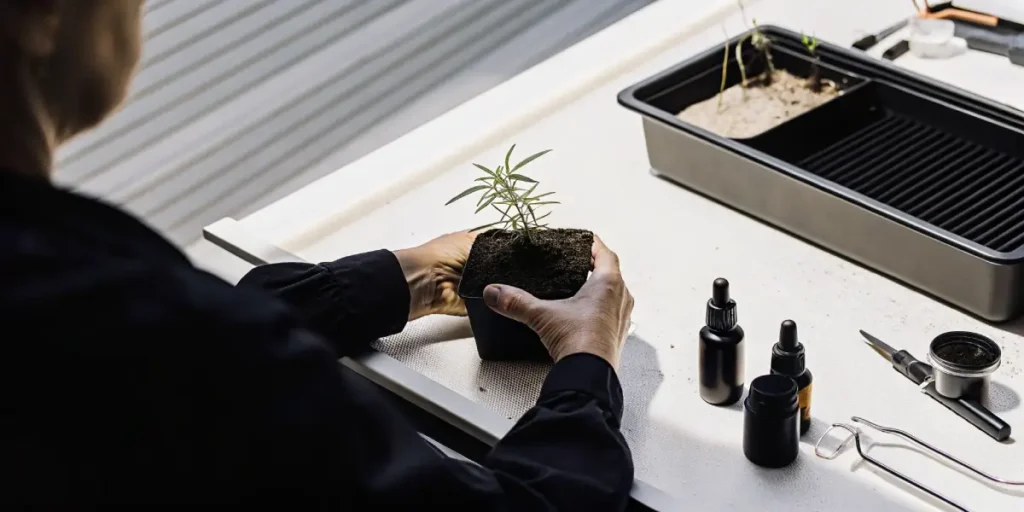
Water Quality
The quality of water used can also affect nutrient flow issues in cannabis due to poor transpiration. Tap water may contain chemicals like chlorine or fluoride, which can accumulate and hinder nutrient uptake. Using filtered or distilled water can help avoid these problems and support better transpiration.
Additionally, check the pH level of the water before use. Cannabis plants prefer slightly acidic conditions, with a pH range of 6.0-7.0. Using a pH meter ensures that the water used is within this ideal range, promoting optimal nutrient absorption.
Improving cannabis transpiration for nutrient flow often requires attention to water quality. Ensuring that water is free from contaminants and within the correct pH range helps in maintaining effective nutrient transport and overall plant health.
Regularly testing water quality and making necessary adjustments can prevent long-term issues and enhance nutrient flow in cannabis by boosting transpiration. Clean, well-balanced water is a fundamental component of a successful growing operation.
Watering Schedule
Establishing a consistent watering schedule helps improve cannabis transpiration for nutrient flow. Random watering can confuse the plant and disrupt its natural processes. By sticking to a regular schedule, you create a rhythm that the plant can rely on, enhancing its ability to uptake nutrients efficiently.
Observe your plants closely to determine their specific watering needs. Factors such as plant size, growth stage, and environmental conditions will influence how much and how often you should water. Adjustments may be needed as the plant grows or as conditions change.
Keeping a journal can be beneficial, allowing you to track watering times, amounts, and any changes in the plant’s health. This record will help you fine-tune your approach and ensure that your cannabis plants receive the care they need to thrive.
Besides to tracking watering patterns, consider implementing automated systems for consistent irrigation. These systems can help maintain a steady watering schedule, reduce human error, and support effective nutrient transport in cannabis plants.

FAQs: How to Fix Nutrient Flow Issues in Cannabis Due to Poor Transpiration
What causes poor transpiration in cannabis plants?
Poor transpiration in cannabis plants can result from several factors, including high humidity, low light conditions, and improper watering. When the air is too humid, the plant cannot release water vapor efficiently, leading to nutrient flow issues. Similarly, if the plant receives inadequate light, it may not transpire effectively.
To address these issues, ensure there is good airflow in the grow area, and maintain an optimal humidity level. Adjusting light exposure and water practices can also improve transpiration. By making these changes, you can support better nutrient uptake and overall plant health.
Another factor that may cause poor transpiration is soil compaction. Compacted soil can limit root growth and hinder water movement, affecting the plant’s ability to transpire and absorb nutrients. Ensuring that the growing medium is well-aerated can alleviate this issue.
Genetic factors can also influence transpiration rates. Some strains may naturally have lower transpiration rates, so selecting strains known for their efficient water use can be beneficial for enhancing nutrient flow in cannabis by boosting transpiration.
How can I improve cannabis transpiration for nutrient flow?
Improving cannabis transpiration for nutrient flow involves optimizing environmental conditions and watering practices. Ensure proper airflow and maintain appropriate temperature and humidity levels to promote efficient water movement through the plant. Using fans can help enhance air circulation, while dehumidifiers and humidifiers can regulate moisture levels.
Additionally, choose cannabis strains that are known for their resilience and ability to thrive under various conditions. Strains like Blue Dream Auto and Banana Kush Auto from Blimburn Seeds can be particularly effective at managing nutrient flow through enhanced transpiration.
Regular maintenance of the growing environment, such as cleaning fans and dehumidifiers, ensures that equipment functions efficiently and supports optimal transpiration conditions. This proactive approach aids in solving nutrient uptake problems in cannabis due to transpiration.
Implementing companion planting strategies can also improve transpiration. Certain companion plants can enhance the microclimate around cannabis plants, promoting better air movement and humidity control, which in turn supports effective nutrient transport.
Can poor transpiration affect cannabis yield?
Yes, poor transpiration can negatively impact cannabis yield. When a plant cannot transpire effectively, it struggles to transport essential nutrients, leading to deficiencies that can stunt growth and reduce the overall yield. Symptoms such as yellowing leaves or slow growth are indicators of these issues.
By addressing the underlying causes of poor transpiration, such as environmental conditions and watering practices, you can enhance nutrient flow and support healthier plant growth. This proactive approach can improve yield and produce more robust cannabis plants.
Beyond immediate yield concerns, poor transpiration can affect the plant’s long-term health and its ability to recover from stress. Ensuring that transpiration functions properly helps in maintaining plant vigor and resilience against environmental fluctuations.
Investing in high-quality cultivation tools and resources can further support efforts to manage transpiration and improve yield. This includes everything from precision instruments for measuring environmental conditions to advanced irrigation systems.
What is the role of nutrient flow in cannabis plant health?
Nutrient flow is vital for cannabis plant health as it ensures that all parts of the plant receive the necessary nutrients for growth and development. Efficient nutrient transport allows the plant to build strong cell structures, produce energy, and carry out essential processes like photosynthesis.
Poor nutrient flow can lead to deficiencies, weakened plant structures, and reduced resistance to diseases and pests. By maintaining optimal transpiration and addressing any issues that arise, you can support better nutrient flow and overall plant vitality.
Knowing how to fix nutrient flow issues in cannabis due to poor transpiration is essential for achieving consistent plant health and maximizing potential yields. Addressing these issues requires a holistic approach that considers all aspects of the growing environment.
Nutrient flow also plays a role in the plant’s ability to produce cannabinoids and terpenes, which are responsible for the plant’s aroma, flavor, and effects. Ensuring optimal nutrient transport can enhance the quality and potency of your cannabis harvest.
How does strain selection affect transpiration and nutrient flow?
Strain selection can significantly influence how well a cannabis plant manages transpiration and nutrient flow. Some strains are naturally more resilient and better equipped to handle fluctuations in environmental conditions, making them ideal for growers facing transpiration challenges.
Choosing strains like Gelato Auto, known for its adaptability, can help ensure more consistent nutrient uptake and healthier plant growth. By selecting the right strains for your growing environment, you can enhance nutrient flow and achieve better results in your cannabis cultivation efforts.
When selecting strains, consider their genetic background and breeding history. Strains bred for specific environments, such as high-altitude or arid conditions, may have traits that improve their transpiration efficiency and nutrient uptake.
Consulting with seed banks or experienced growers can provide insights into which strains perform best in your specific growing conditions. This knowledge can guide you in making informed decisions that support effective nutrient flow and plant health.


